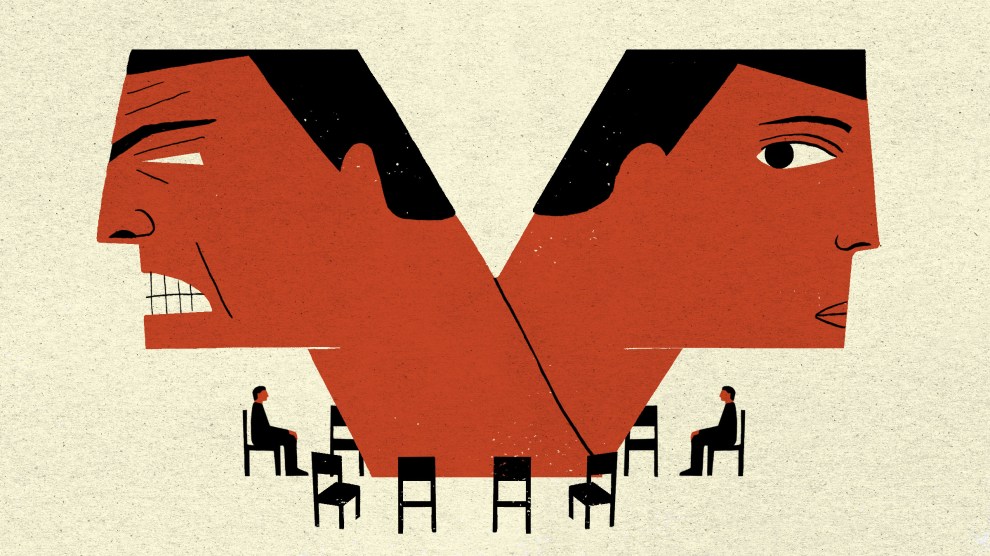
In a drab college classroom in Oakland, California, about a dozen men sit in a half-circle of desks, arranged in order of who’s been coming here the longest. The guy with 21 weeks under his belt sits farthest from the door while the guys with more than 40 weeks sit closest to it.
“I thought it was your last week?” asks a man with about 30 weeks.
“Nah, I decided to keep going,” responds one with 42 weeks. “I went too far to quit now.”
Right at 6:30 p.m., the group’s most senior member, 46 weeks, walks in. Everyone calls out his name. Fist bumps follow.
Joshua Ewing arrives shortly afterward. A 34-year-old covered in prison tattoos, Ewing first came to this classroom more than three years ago after he was convicted of punching and choking his girlfriend. A judge sentenced him to probation and required him to go to a batterer intervention program. Today Ewing says he’s not the man he used to be, thanks to Men Creating Peace (MCP), a nonprofit certified by Alameda County’s probation office. Though he graduated from the program about two years ago, he still regularly comes to meetings and has facilitated sessions for the men, most of whom are here by court order stemming from domestic abuse charges. “I like to show them that it’s possible to change,” he says.
MCP’s one-year curriculum teaches men with a history of violence how to defuse their anger by using tools like breathing exercises, and provides them with language to understand when their “authentic self” gives way to “the hit man” who acts on his rage. It’s also a crash course in understanding male privilege and the “male-role belief system” that fosters violence toward women. Over the next two hours, a sprightly sixtysomething man in a plaid shirt sits in the center of the semicircle and recounts the chain of events that ended with him being sent to the program. He describes the moment before he lost control and attacked his wife: “I hear, but I can’t make out the words. Like Charlie Brown.” He imitates the wah-wah sound adults make in “Peanuts” cartoons. He rocks back and forth in his chair. Face flushed, he wipes his brow.
The first batterer intervention program, or BIP, was founded in Boston in 1977 by men who wanted to combat the misogynistic attitudes they viewed as the root of abusive behavior. In the 1980s, under increasing political pressure from women’s groups, many states passed stricter domestic violence laws, resulting in more offenders facing mandatory arrest. As courtrooms filled with abusers, judges began to send them to BIPs. In 1994, California mandated BIPs for probationers with domestic violence convictions. Programs sprang up around the country, becoming one of the justice system’s primary ways of dealing with domestic abusers. Today, more than half a million men attend about 2,500 BIPs annually.
Yet these programs have spread without much sense of whether they work. “Batterer intervention programs weren’t really designed with the criminal justice system in mind,” says Dana Radatz, a criminal justice researcher at Niagara University. “The criminal justice system saw them as an opportunity after the fact.” While some men benefit from these programs, studies show they have a minimal effect on whether offenders commit another violent offense. “There’s this crisis of confidence in domestic violence treatment,” says David Martin, a prosecutor who heads the domestic violence unit in King County, Washington, which includes Seattle. “Domestic violence is a second-class crime, and this is a byproduct of that—that the most common intervention we have is we’re going to send people to batterers’ treatment. You can’t honestly tell victims that this is the right thing to do.”
Many BIPs incorporate aspects of the Duluth Model, a decades-old curriculum based on the belief that domestic violence is fundamentally rooted in patriarchy. Its curriculum does not include factors that may influence abusers, such as mental health issues, substance abuse, or a history of trauma, even though these issues often come up in treatment groups. In 2013, the Washington State Institute for Public Policy found that Duluth-inspired programs had no effect on recidivism rates among domestic violence offenders. The Veterans Health Administration prohibits the use of the Duluth Model in its own programs for addressing domestic violence among veterans.
Recent research on BIPs has found that teaching abusers about their role in the patriarchy may not be the best way to keep them from acting violently again—mostly because domestic violence offenders are not that different from other violent offenders. “People in [BIPs] often have criminal histories, and they’re being rearrested for a wide variety of offenses that include domestic violence but are not exclusive to domestic violence,” says Tara Richards, a criminologist at the University of Nebraska-Omaha who has studied the effectiveness of BIPs. “We have to take that information and we have to say, ‘Okay, how are we going to treat these clients differently in a way that’s actually going to meet their full spectrum of needs?’ Because that’s when we’re going to see a reduction in domestic violence.”
Radatz’s research focuses on applying evidence-based principles that have been shown to work in other rehabilitation efforts, like drug courts, to programs for domestic violence offenders. This approach is spreading. Colorado has started to assess what kind of treatment offenders need, including individual therapy and substance abuse treatment. New York City is creating evidence-based curriculums and building partnerships with community-based, culturally specific programs. Miami-Dade County is bringing domestic violence offenders into its drug court. Six California counties are experimenting with innovative approaches to treating abusers. Iowa recently switched to a program based on behavioral therapy strategies. Most of these efforts are state-funded, unlike most programs, which offenders must pay for themselves—often $1,400 or more.
Recidivism remains the clearest indication of whether programs for abusers are working. The Washington State Institute for Public Policy found that a felony domestic violence conviction was one of the best predictors of whether someone might commit a violent crime in the future. A Washington Post look at five cities found that at least a third of men who murdered their partners had restraining orders or previous convictions for domestic abuse or other violent crimes. A Mother Jones analysis shows that 22 recent mass shooters had histories of domestic abuse. Martin, the Seattle prosecutor, mentions the case of a six-time domestic violence offender who was viewed as a model participant in his batterer intervention program. After completing his treatment, he brutally beat his girlfriend again. “It’s that type of recidivism that has such a corrosive and insidious effect on a community,” Martin says.
Ewing says he initially thought Men Creating Peace wouldn’t work. “I came in like extremely violent,” he recalls. He’d grown up in an abusive home; his father, “an outlaw biker,” taught him that men should be above women. At the time he started MCP, Ewing was struggling with drug addiction and had been in and out of prison for aggravated robbery, grand theft auto, and assault. He was homeless and often getting into fights. “If violence didn’t solve the problem, nothing did,” Ewing says. “That’s all I knew.”
“MCP provided consistency and was like my only two and a half hours of normalcy that I had in my life,” he says. Ewing is now training to become a barber and has stayed out of the criminal justice system, though he admits that a few months earlier he got into a fistfight and broke a man’s jaw. He says he hasn’t been violent toward women since he finished the program and is now “able to just walk away” when he feels his anger rising. “And that transformed into healthier friendships, healthier relationships with co-workers and family members, healthier communication skills—happier,” he says.
In the center of the room, the man who recounted the moments before he beat his wife sits in his undershirt, visibly exhausted, after finishing his story. When he opens his eyes again, Ewing asks him, “Who is here now?” The man struggles for words for a moment. “I am the caring, loving human being that I am,” he answers. When the meeting is over, the man thanks Ewing and MCP’s director, jokingly lamenting that he’s only got a few weeks left in the program. He promises he’ll keep coming to meetings even when he’s no longer required to, saying what a difference it’s made for him. Then he buttons up his shirt and walks into the night.














